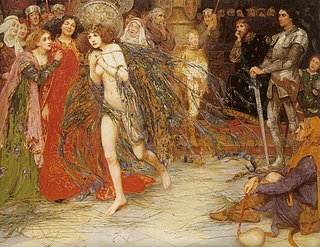"The Whummil Bore" (Roud 3722, Child 27) is an English-language folk song. A whummil is a tool for drilling holes.
"The Whummil Bore" (Roud 3722, Child 27) is an English-language folk song. A whummil is a tool for drilling holes.
The narrator served the king seven years and "saw his daughter only once"—meaning saw her naked, through a whummil bore. She was being dressed by her maids.
Only one variant of this ballad exists. [1] "Hind Horn" appears to contain a stanza from it. [2]
This is recorded on the Steeleye Span 2006 album Bloody Men.
Sir Aldingar is an English-language folk song. Francis James Child collected three variants, two fragmentary, in The English and Scottish Popular Ballads. All three recount the tale where a rebuffed Sir Aldingar slanders his mistress, Queen Eleanor, and a miraculous champion saves her.
"The Laily Worm and the Machrel of the Sea" is an English-language folk song. 'Machrel' is an archaic spelling of 'mackerel', the type of fish, and title can be spelled either way.

"Hind Horn" is a traditional English and Scottish folk ballad.
"The Queen of Elfan's Nourice" or "The Queen of Elfland's Nourice" is an English-language folk song, although fragmentary in form.
"Hind Etin" is a folk ballad existing in several variants.
Fair Annie is a traditional folk ballad, existing in several variants.
Child Waters is an English-language folk song, existing in several variants.
The Gay Goshawk is a traditional English-language folk ballad.
"The Fair Flower of Northumberland" is a folk ballad.
Leesome Brand is an English-language folk song.
"Sheath and Knife" is a folk ballad.

Fause Foodrage is a Scottish murder ballad of the 17th or 18th century. It was first printed by Walter Scott in Minstrelsy of the Scottish Border (1802). Scott cited Elizabeth, Lady Wardlaw as the ballad's probable author.

"The Boy and the Mantle" is an Arthurian folk ballad. Unlike the ballads before it, and like "King Arthur and King Cornwall" and "The Marriage of Sir Gawain" immediately after it in the Francis James Child collection, this is not a folk ballad but a song from professional minstrels.
"Gil Brenton" is an English-language folk song, existing in several variants.
"The Marriage of Sir Gawain" is an English Arthurian ballad, collected as Child Ballad 31. Found in the Percy Folio, it is a fragmented account of the story of Sir Gawain and the loathly lady, which has been preserved in fuller form in the medieval poem The Wedding of Sir Gawain and Dame Ragnelle. The loathly lady episode itself dates at least back to Geoffrey Chaucer's "Wife of Bath's Tale" from The Canterbury Tales. Unlike most of the Child Ballads, but like the Arthurian "King Arthur and King Cornwall" and "The Boy and the Mantle", "The Marriage of Sir Gawain" is not a folk ballad but a song for professional minstrels.
"Erlinton" is an English-language folk ballad. One variant features Robin Hood, but this variant forces the folk hero into a ballad structure where he does not fit naturally.
"Earl Brand" is a pseudo-historical English ballad.
"Young Andrew" is a folk song catalogued as Child ballad 48.
"Brown Robyn's Confession" is an English-language folk song.
"The King's Dochter Lady Jean", also called "The King's Daughter," "Fair Rosie Ann," or "Queen Jane", is an English-language folk song.